This notebook was created by Sergey Tomin (sergey.tomin@desy.de) for IPC seminar. October 2020.
Optimization Toy
Here, we consider a simple example of accelerator parameter optimization with OCELOT. The goal is to demonstrate the benefits of using a Python accelerator library like OCELOT.
from ocelot import *
from ocelot.gui import *
import copy
initializing ocelot...
Lattice: buch compressor
d = Drift(0.5)
# Quadrupoles
qf = Quadrupole(l=0.2, k1=1, k2=2)
qd = Quadrupole(l=0.2, k1=-1, k2=-2)
# Bends
angle0 = 14*np.pi/180
b1 = SBend(l=0.5, angle=angle0, e2=angle0, eid='B1')
b2 = SBend(l=0.5, angle=-angle0, e1=-angle0, eid='B2')
b3 = SBend(l=0.5, angle=-angle0, e2=-angle0, eid='B3')
b4 = SBend(l=0.5, angle=angle0, e1=angle0, eid='B4')
m1 = Marker(eid="START")
m2 = Marker(eid="SCREEN")
chicane = (b1, d, b2, d, d, b3, d, b4)
fodo = (qf, d, qd, d)
cell = (m1, d, chicane, d, fodo, m2)
lat = MagneticLattice(cell, method={"global": SecondTM})
Twiss parameters
tws0 = Twiss()
tws0.beta_x = 10
tws0.beta_y = 10
tws0.alpha_x = 0
tws0.alpha_y = 0
tws0.E = 100e-3
tws = twiss(lat, tws0)
plot_opt_func(lat, tws)
plt.show()
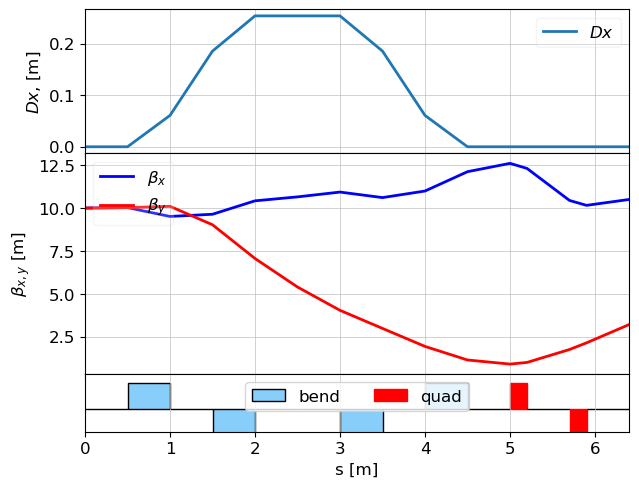
R = lattice_transfer_map(lat, energy=100e-3)
print(R[4,5])
-0.10311173034412162
Generate the electron beam - ParticleArray
p_array_init = generate_parray(sigma_x=1e-3, sigma_px=5e-5, chirp=0.01,
nparticles=20000, charge=1e-09, energy=tws0.E, tws=tws0)
show_e_beam(p_array_init, figsize=(9,6))
plt.show()
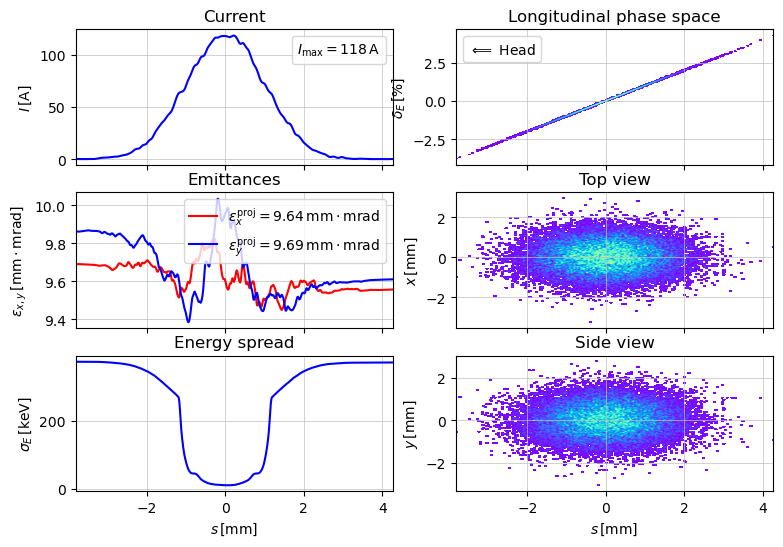
Track the beam through the lattice
p_array = copy.deepcopy(p_array_init)
navi = Navigator(lat)
#navi.unit_step = 0.1
#csr = CSR()
#csr.sigma_min = 4e-6
#navi.add_physics_proc(csr, m1, m2)
tws_track, _ = track(lat, p_array, navi)
show_e_beam(p_array, figsize=(9,6))
plt.show()
z = 6.4 / 6.4. Applied:
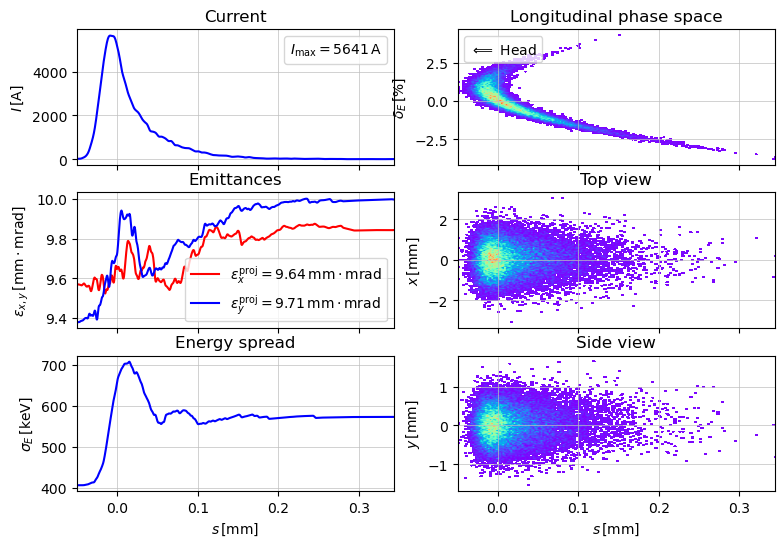
What does the screen show?
show_density(p_array.x()* 1e3, p_array.y() * 1e3,
xlabel="x [mm]", ylabel='y [mm]', title="Screen", limits=[(-4, 4), (-2, 2)])
print(f"std(x) = {np.std(p_array.x()) * 1e6} um; std(y) = {np.std(p_array.y()) * 1e6} um;")
std(x) = 719.0758746359667 um; std(y) = 399.0834500527979 um;

What if we have not identical dipoles?
p_array = copy.deepcopy(p_array_init)
b1.angle = angle0 * (1 + .02)
b2.angle = -angle0 * (1 - .02)
b3.angle = -angle0 * (1 - .02)
b4.angle = angle0 * (1 + .02)
lat.update_transfer_maps()
tws = twiss(lat, tws0)
plot_opt_func(lat, tws, legend=False)
plt.show()
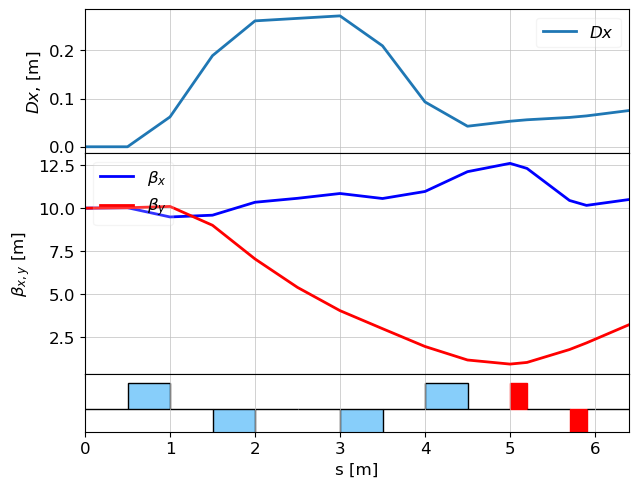
Has the beam size on the screen changed?
navi = Navigator(lat)
tws_track, _ = track(lat, p_array, navi)
print(f"std(x) = {np.std(p_array.x()) * 1e6} um; std(y) = {np.std(p_array.y()) * 1e6} um;")
show_density(p_array.x()* 1e3, p_array.y() * 1e3,
xlabel="x [mm]", ylabel='y [mm]', title="Screen", limits=[(-4, 4), (-2, 2)], grid=False)
z = 6.4 / 6.4. Applied: std(x) = 1037.9069892477612 um; std(y) = 398.90408947079084 um;
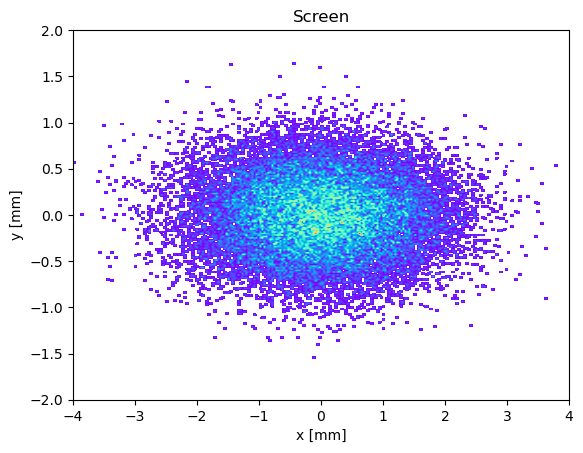
Let's minimize the horizontal beam size (dispersion?) on the screen with two last dipoles.
from scipy.optimize import minimize
# Our objective function
def get_beam_size(angles):
p_array = copy.deepcopy(p_array_init)
b3.angle = angles[0]
b4.angle = angles[1]
lat.update_transfer_maps()
# NOTE: for simplicity, we do not take into account changes in the drift length between dipoles B3 and B4.
navi = Navigator(lat)
# navi.unit_step = 0.1
# csr = CSR()
# csr.sigma_min = 4e-6
# navi.add_physics_proc(csr, m1, m2)
tws_track, _ = track(lat, p_array, navi)
return np.std(p_array.x())
angles = np.copy([b3.angle, b4.angle])
print(f"init: angles = {angles}")
res = minimize(fun=get_beam_size, x0=angles)
print()
print(f"res: angles = {res['x']}")
init: angles = [-0.23945917 0.24923302]
z = 6.4 / 6.4. Applied:
res: angles = [-0.43648764 0.50760325]
p_array = copy.deepcopy(p_array_init)
navi = Navigator(lat)
tws_track, _ = track(lat, p_array, navi)
show_density(p_array.x()*1e3, p_array.y()*1e3, xlabel="x [mm]", ylabel='y [mm]', limits=[(-4, 4), (-2, 2)])
print(f"std(x) = {np.std(p_array.x()) * 1e6} um; std(y) = {np.std(p_array.y()) * 1e6} um;")
z = 6.4 / 6.4. Applied: std(x) = 162.60623447637025 um; std(y) = 492.3983116819463 um;
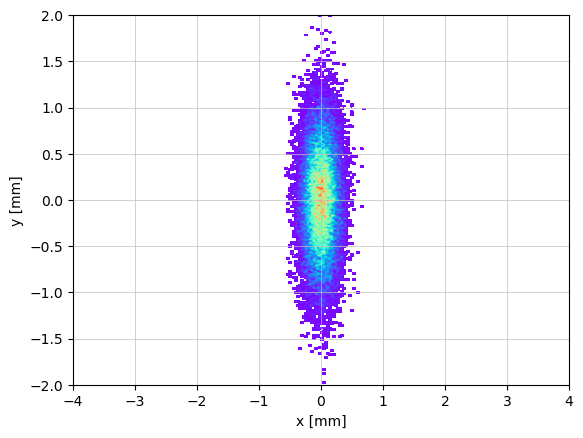
What is going on? Let's have a look to the twiss parameters
tws = twiss(lat, tws0)
plot_opt_func(lat, tws, legend=False)
plt.show()
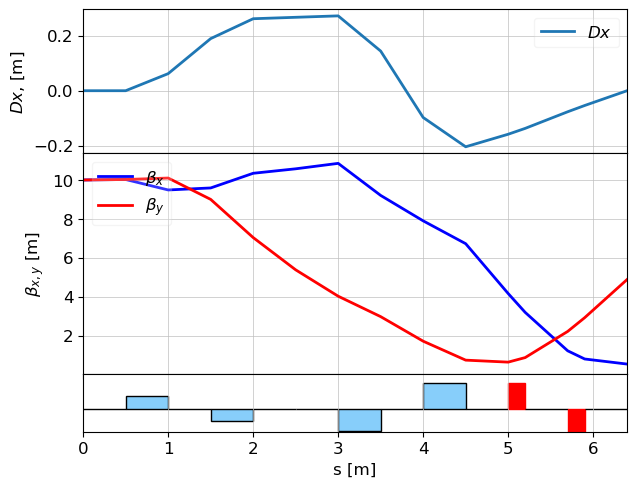
show_e_beam(p_array, figsize=(9,6))
plt.show()

R = lattice_transfer_map(lat, energy=100e-3)
print("R56 = ", R[4,5])
R56 = -0.24092917476178766